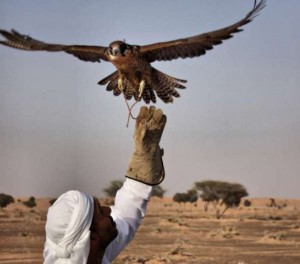Week 31 – 12 February 2017:
The Wanderer
By anyone’s standards, the Peregrine Falcon is a remarkable bird. They number somewhere between 140,000 and 440,000 individuals, and occupy an area of approximately 387 million square kilometres. There are more than a dozen subspecies of Peregrine Falcon, found in nations from Afghanistan to Zimbabwe, from Moldova to Mozambique. When an individual goes into a hunting stoop, it may achieve speeds of up to 350 km, faster than any other animal. Peregrines are big, bold and beautiful. But sometimes the most interesting details are the tiniest ones.
Consider the delightfully-named Marmaduke Tunstall. A British ornithologist, in 1771 he formally described the Peregrine Falcon for the first time. As part of his description, he gave it the scientific name Falco peregrinus. The first part of the name is straightforward, based on a Latin word for sickle – a reference to its curved talons. The second part of the name is derived from another Latin word meaning stranger or wanderer. According to a dictionary of scientific bird names by James Jobling, this is a reference to a belief in the world of falconry that a young bird captured on its first migration is better suited to the sport than a bird taken from a nest as a youngster.
Falconry continues to be a part of the cultural heritage of people of the Arabian Peninsula, and Peregrine Falcons remain a key species. Traditionally, a falcon would be caught on its southward migration, held during the winter falconry season, and then released so as to avoid the trouble of keeping them through the long, hot summer, as indicated by Tunstall. In Arabia today, falconry uses both wild-caught and captive-bred birds.
A recently-published paper by Aleksandr Sokolov of the Russian Academy of Sciences and his colleagues reported on Peregrines breeding on the Yamal Peninsula of northwestern Siberia, Russia. Falcons breed at low density. Even so, Sokolov et al. documented 59 nesting attempts in 16 breeding ranges between 2008 and 2014. Some of their study involved tracking the movements of birds using satellite transmitter, but some of the work was decidedly less high-tech. Aggressive nest defense of the adult falcons made it possible to get a close look at them. The researchers found that some birds were wearing jesses as used in Arabian falconry. A jess is a short leg-strap made of silk, leather, cotton or nylon. It is used to fasten the falcon to a leash.
The sample size of birds wearing jesses in the study was understandably small, but the stories of individual birds were remarkable. In one case, a female at a nest with four chicks in 2013, and three eggs in 2014, had a blue leg band as well as jesses. The leg band had the telephone number and name of the falconer in Arabic script. When contacted, the falconer indicated that he had captured the bird as an adult on the Red Sea coast of Saudi Arabia in September 2011, but had lost it while hunting about six weeks later.
It is unlikely that the Peregrine Falcons observed in Russia had been intentionally released while still wearing jesses. Like the breeding female described, they were likely escapees. One of the most important messages to come from the research of Sokolov et al. is that these falcons have the potential to breed after a period of use in falconry. The International Union for the Conservation of Nature considers the Peregrine to be of least concern, and with a stable population. In some regions, their populations seem to be increasing. “It appears that the current harvest level of peregrines for Arabian falconry has not prevented breeding population increases and is unlikely to be currently limiting the breeding population… in its northern Eurasian breeding sites.”
Sokolov, A., V. Sokolov, and A. Dixon. 2016. Return to the wild: migratory Peregrine Falcons breeding in Arctic Eurasia following their use in Arabic falconry. J. Raptor Research 50:103-108.
Photo credits: Arab falconer with Peregrine Falcon – www.greenprophet.com; Peregrine Falcon stamp, USSR – www.shutterstock.com



